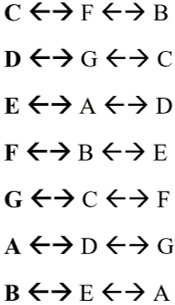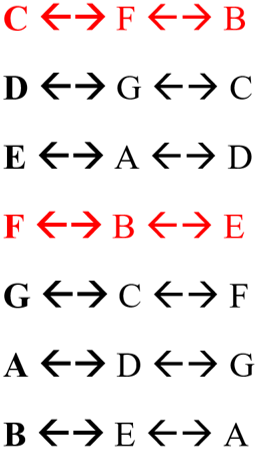Quartal harmony, as the name implies, refers to intervals of fourths. Basically, the idea is to build chords using intervals of fourths instead of intervals of thirds.
We have already learned in previous topics that chords are formed from intervals of thirds. These intervals can be major or minor thirds, forming major and minor chords, major chords with major seventh, major chords with minor seventh, etc.
For example, the Cmaj7 chord has the notes C, E, G, B. The distance between C and E is four semitones (major third). Between E and G we have three semitones (minor third). Between G and B we have four semitones (major third).
You can do this test for all chords in a major key and you will see that the intervals are always on thirds. This starts from the very principle of chord formation in a tonality, as we studied in the topic about chords of a key.
We saw that on the C major scale, for example, to form a certain chord it would be enough to start at the note of the chord in question and jump every two notes, as in the example below. Note: we will place the scale in two octaves to make the formation of the chords more clear.
- C major scale notes: C D E F G A B C D E F G A B
- Forming the D chord: C D E F G A B C D E F G A B
- Resulting chord: Dm7
- Forming the E chord: C D E F G A B C D E F G A B
- Resulting chord: Em7
By jumping every two notes on the scale, we are using intervals of thirds. In other words, if we consider that the source note is the first degree, the next note is the second degree, and the next is the third degree. That’s why jumping in twos we have intervals of thirds.
Forming intervals of fourths
So how could we form chords using intervals of fourths? Just jump every three notes!
- C major scale notes: C D E F G A B C D E F G A B
- Forming the D chord using intervals of fourths: C D E F G A B C D E F G A B
- Resulting chord: Dm7(add4)
- Forming the E chord: C D E F G A B C D E F G A B
- Resulting chord: Em7(add4)
- Forming the F chord: C D E F G A B C D E F G A B
- Resulting chord: Fmaj7(b5)
Try playing these chords on your instrument one after the other to get the feeling of the quartal harmony. You will notice that the sound is very interesting, a little enigmatic.
Following the same logic, you can form all other chords, on any major scale.
Great, we have learned how to put a quartal harmony together, but what is it good for in practice?
How to use the quartal harmony?
One of the most common applications of quartal harmony is to play several fourth chords while another instrument is fixed on the same chord. For example, if the band is resting on the D minor chord, you can think of the Dorian mode (as we have already mentioned in the music modes topic) and play – therefore – all the fourth chords generated from that mode.
To find out which chords are generated from the mode in question, just locate yourself in relation to the major scale. For example, if you are going to play a Dorian chord, it means that you are two semitones above the tonic that formed the major scale. As a result, the next chord will be a minor chord with an added fourth, located two semitones above that chord. For example: if we are playing D Dorian, the chord in question will be Dm7(add4) and the next chord (two semitones above) will be Em7(add4). If we are playing A Dorian, the chord in question will be Am7(add4) and the chord located two semitones above will be Bm7(add4).
Knowing how to locate yourself in modes everything becomes simple. You can memorize the shapes of the fourth chords and practice the idea of playing several of these chords in sequence. Then, use this idea on top of a song that you like, at a time when a chord remains static for a long time; take this time to use quartal harmony.
It is worth emphasizing that the use of quartal harmony is more common within the modal concept. That is, if the song is resting on a major chord, you can use quartal harmony considering that chord as Lydian. If the chord is minor, you can think of it as being Dorian. If this is obscure for you, we recommend that you go back and review the topic of modal harmony.
Improvising solos in quartal harmony
The idea of quartal harmony also serves for solos. First, let’s look at some interesting facts about quartal openings on a major scale.
C major scale notes: C D E F G A B
Let’s make two quartal openings from each of the notes on this scale:

If we are going to count the exact distance of each of these intervals, we will find that some intervals are perfect fourths and others are augmented fourths. In reality, practically all intervals are perfect fourths, except the F – B / B – F interval, which consists of an augmented fourth.
Therefore, we will eliminate the notes that have the F – B intervals from the previous table (we highlight them in red when these intervals appear):

Considering only the resulting notes (starting from the notes of origin from the left), we are left with: D, E, G, A, B. These are the notes of the major pentatonic scale of G!
That is, if we want to keep only the perfect fourth intervals of a major scale, we end up forming a pentatonic scale. So we can use this pentatonic in our solos to provide a quartal characteristic.
Note that the resulting scale here was the major pentatonic scale of G, not C. We can also think of its relative (E minor pentatonic).
So, to know the right pentatonic to use to provide a quartal characteristic to the solo, just find a good way to locate yourself. Here are some tips:
- If the resting chord is minor, you will think of the Dorian mode, so the minor pentatonic will be located two semitones up. Example: chord of D minor, thinking of D Dorian, we have the pentatonic of E minor.
- If the resting chord is major, you will think in Lydian mode, so the major pentatonic will be located two semitones above. Example: F major chord, thinking of F Lydian, we have the pentatonic of G major.
With that in mind you can now add many interesting features to your songs. It’s time to let creativity flow. Practice these concepts a lot. And don’t worry, in these more advanced matters, it is perfectly normal to take a long time to be able to internalize and put them into practice. The more advanced the subject of music theory is, the more time it will take for you to be able to turn that theory into practice. So get to work, you have a lot of homework to practice!
Go to: Module 10
Back to: Module 9
